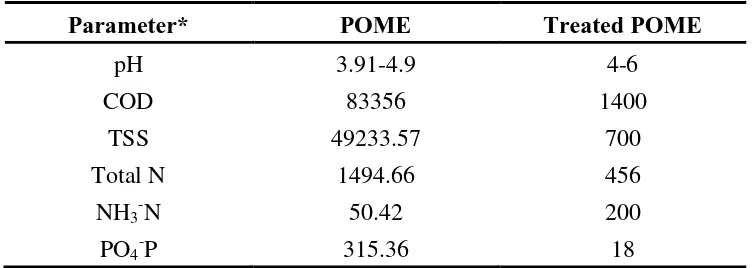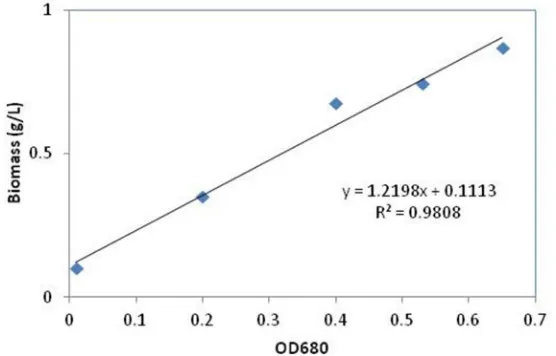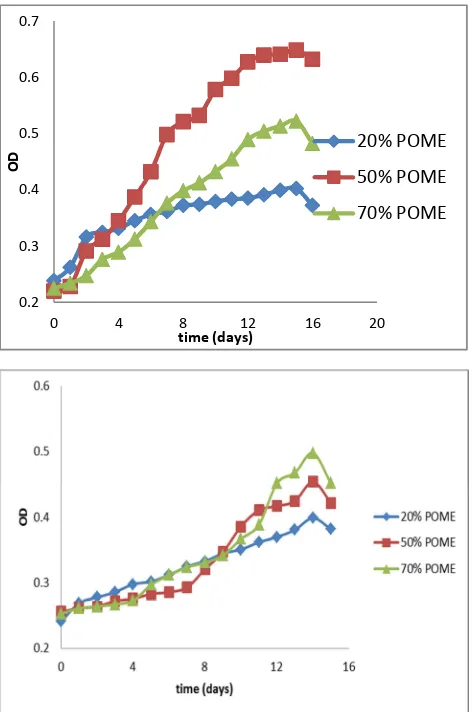Copyright © 2012 by Modern Scientific Press Company, Florida, USA
Potential of Palm Oil Mill Effluent (POME) as Medium Growth
of Chlorella sp for Bioenergy Production
Hadiyanto * and M.M.A. Nur
Center of Biomass and Renewable Energy (C-BIORE), Chemical Engineering Department, Diponegoro University, Jl. Prof. Sudharto SH, Tembalang, Semarang 50239, Indonesia
* Author to whom correspondence should be addressed; E-Mail: [email protected]; Tel.: +62-24-7460058; Fax: +62-24-76480675.
Article history: Received 12 June 2012, Received in revised form 7 August 2012, Accepted 8 August 2012, Published 15 August 2012.
Abstract: Energy is essential and vital aspect for development in Indonesia. Biodiesel has received much attention as renewable energy in recent years according to lack of petroleum energy. One of potential biodiesel is produced from microalgae. Earlier research was reported that palm oil mill effluent (POME) is potential medium to be used as microalgae to grow because contain high nutrient source. The objective of the research is to determine growth rate and biomass productivity in Chlorella sp cultured in POME concentration using urea as nitrogen source. Chlorella sp was cultured in 20-70% POME using additional urea with concentration of 0.1 g/L and 1 g/L at a flask disk, pH 6.8-7.2; aerated using aquarium pump and fluorescence lamp 3000-6000 lux as light source. The biomass concentration was measured using spectrophotometer Optima Sp-300 OD at 680 nm wavelength within 15 days cultivation to calculate specific growth rate. At the end of cultivation, Chlorella sp was filtered and measured as dry weight. Result indicated that
Chlorella sp at 50% POME and 1g/L urea showed a higher specific growth rate (0.066/day).
Keywords:Chlorellasp; POME; microalgae; biodiesel; biomass.
Indonesia is a largest producer of crude palm oil (CPO) in the world. In 2008, Indonesia produced 44% of shared demand of CPO from around the world (Rupani et al., 2010) and from 2005 to 2008 the production rose up to 8.88%. Moreover, the production is still increasing as predicted from 2010 to 2014, it will grow at about 5.22% per annum (Table 1). About 1 ton fresh fruit bunch (FFB) can be converted to 0.2 ton CPO, while 0.66 ton will be released as palm oil mill effluent (POME). This enormous amount of POME was produced due to high amount of water used.
Table 1. Commodities of Indonesia agriculture 2010-2014
Commodities Year Growth/annum
Table 2. POME and treated POME characteristic
Parameter* POME Treated POME
The need of renewable energy in Indonesia can not be avoided since within 15 years, the oil reserve will be diminished. Therefore, finding new source of renewable energy is really essential and vital aspect for Indonesia. One of the potential renewable energy resources is microalgae. The productivity of microalgae as compared to terrestrial plant is higher (Chisti, 2007) while the lipid content varies between 30-60%. Therefore, the objective of this paper is to utilize POME as growth medium of microalgae especially Chlorella sp.
2. Experimental Method
2.1. Cultivation Medium
Medium for cultivation, POME was collected from PTPN VII, Lampung. To be used as medium, POME was pretreated to eliminate solid materials and bacterial content.
2.2. Culture Chlorella sp
Chlorella sp was provided by BBPAP Jepara and cultivated in a modified medium with consists of 40 ppm urea, 30 ppm TSP, 10 ppm ZA, 1 ppm FeCl3 and 25 µg/L vitamin B12.
Chlorella sp was cultivated in different POME concentration (20, 50 and 70%) and different low-high urea concentration (0.1 and 1 g/L). Light intensity was maintained in 3000 lux, pH 6.8-7.2, 28 oC temperature, and aerated using aquarium air pump to mix the medium in 1 L glass flask disk.
2.3. Measurement
The concentration of biomass was measured using spectrophotometer Optima sp-300, 680 nm wavelength for 15 days in every day. The optical density was plotted in biomass to make regression between optical density and biomass. Specific growth rate was calculated using equation from exponential growth (Eq 1):
Biomass was harvested in the end of cultivation using control pH 11 (Oh et al., 2001). Biomass
was dried at 55 oC tray dryer for 2 h and the productivity (x) (mg/L/d) was calculated using produced
biomass divided by cultivation time.
3. Results and Discussion
Fig. 1 shows that the linear correlation between biomass and optical density was found. It was confirmed that OD 1 = 1.22 g/L. This is slightly different with the one obtained by Puangbut & Leesing (2012) with y = 1.5343x, (R2 = 0.977). The specific growth rate was determined by Eq 1 and the result is depicted in Table 3. The result indicates that 50% POME and 1 g/L urea has the highest specific growth rate (µ) than other variables.
Figure 1. Correlation between OD and dry mass Chlorella sp cultivated in POME at 680 nm.
3.2. Effect of Urea Addition in POME to Algae Growth
The growth of algae in POME was evaluated by addition of external nutrient i.e. urea with concentration of 0.1 and 1 g/L. The result (Table 3) shows that Chlorella sp in this experiment has lower growth rate compared to the one obtained by Putri et al. (2011) with µ = 0.084/day. The alga cell growth and the effect of urea in the medium are shown in Fig. 2. The use of 1 g/L urea as micro-nutrient enhanced the growth of algae both in achieving maximum optical density and shorter lag phases. This is an evidence that for completion of photosynthetic reaction, POME need additional nutrients.
Table 3. Specific growth rate (day -1) Chlorella sp in different POME and addition of urea concentration
Urea POME concentration
20% 50% 70%
0.1 g/L 0.020 0.057 0.058
Figure 2. Growth phase Chlorella sp in different POME medium: (a) growth Chlorella sp in 1 g/L urea; (b) growth of Chlorella sp in 0.1 g/L urea.
3.3. Effect of Different Medium
The comparison of Chlorella`s growth both in control and POME medium were shown in Fig. 3. The control modified medium is optimum medium with composition of 40 ppm urea, 30 ppm TSP, 10 ppm ZA, 1 ppm FeCl3 and 25 µg/L vitamin B12. In this medium, Chlorella can adapt and grow
well achieving OD = 0.52 with growth rate of 0.85/day. The utilization of POME 50% and 1 g/L urea could achieve high density biomass of OD = 0.5, however, the growth rate is only 0.43/day, while without addition of urea shows even lower optical density.
3.4. Productivity
Figure 3. Thecomparison growh of Chlorella sp in different POME medium and control medium.
At higher POME concentration, the productivity is lower, due to tannin acid. This is supported by Habib et al. (2003) who stated that higher POME concentration influences dark brown color in medium which may come from tannic acid. Tannic acid can inhibit through shading effect in light intensity and photosynthetic reaction.
As compared to 50% POME (1 g/L urea), it has higher nitrogen ratio, but Chlorella still grow in higher specific growth rate. Lower tannic acid in 50% POME influence growth of microalgae, although nitrogen source is high but Chlorella still can tolerant to his condition. Chlorella sp has lower specific growth rate in POME 20% although the medium has lower tannic acid and more light intensities. This lower growth rate is caused by high nitrogen content. The excessive nitrogen content can be an inhibitor if it can not be utilized to form biomass.
Table 4. Biomass productivity (mg/L/d) in different concentration of POME and urea
Urea POME concentration
20% 50% 70%
0.1gr/l 37.8 38.2 42
1gr/l 46.3 58.4 48.93
4. Conclusions
medium, while the other benefits would be reduction of external nutrients such as NaHCO3, urea and
micronutrients. The advantages are the clean treated POME after the harvesting of algae biomass.
Acknowledgments
This research is funded through Hibah Kompetensi 2012 DIKTI with SPK No 164a.4/UN7.5/PG/2012 and this project is partly funded by project Indonesian Aquatic Biomass, with consortium members: PT Wirana, Maris Project BV, PTPN VII Lampung, and KU Leuven Belgium.
References
Cheirsilp, B., and Torpee, S. (2012). Enhanced growth and lipid productivity of microalgae under mixotrophic culture condition: Effect of light intensity, glucose concentration and fed-batch cultivation. Bioresour. Technol., 110: 510-516.
Chisti, Y. (2007). Biodiesel from microalgae. Biotechnol. Adv., 25: 294-306.
Choochote, W., Paiboonsin, K., Ruangpan, S., and Pharuang, A. (2010). Effects of urea and light intensity on the growth of Chlorella sp. The 8th International Symposium on Biocontrol and Biotechnology.
Deptan. (2009). Rancangan Rencana Strategis Kementrian Pertanian Tahun 2010-2014.
Edwards, P., Sinchumpasak, O. A., and Ouano, E. A. O. (1980). A study of a sewage fed high rate stabilization pond in Thailand: Wastewater and resources recovery (IDRC-15e). International Development Research Centre, Ottawa, Canada, p. 42.
Habib, M. A. B., Yusoff, F. M., Phang, S. M., Kamarudin, M. S., and Mohamed, S. (1998). Chemical characteristics and essential nutrients of agro industrial effluents in Malaysia. Asian Fish. Sci., 11: 279-286.
Habib, M. A. B., Yusoff, F. M., Phang, S. M., Kamarudin, M. S., and Mohamed, S. (2003). Growth and nutritional values of Molina micrura Fed on Chlorella vulgaris grown in digested palm oil mill effluent. Asian Fish. Sci., 16: 107-119.
Oh, H. M., Lee, S. J., and Park, M. H. (2001). Harvesting of Chlorella vulgaris using a bioflocculant from Paenibacillus sp. AM49. Biotechnol. Lett., 23: 1229-1234.
Puangbut, M., and Leesing, R. (2012). Integrated cultivation technique for microbial lipid production by photosynthetic microalgae and locally oleaginous yeast. World Acad. Sci. Eng. Technol., 64: 123-131.
Putri, E. V., Din, M. F. M., Ahmed, Z., Jamaluddin, H., and Chelliapan, S. (2011). Investigation of microalgae for high lipid content using palm oil mill effluent (POME) as carbon source.
Press, Singapore.



